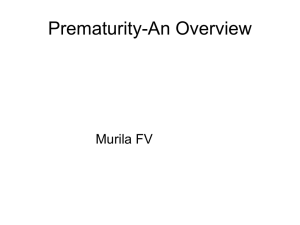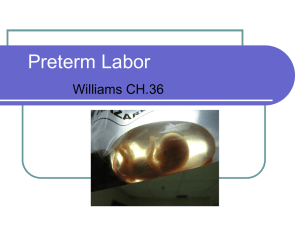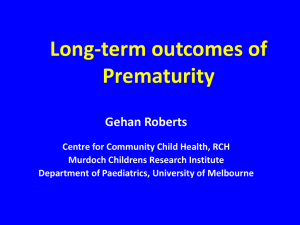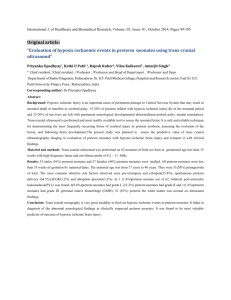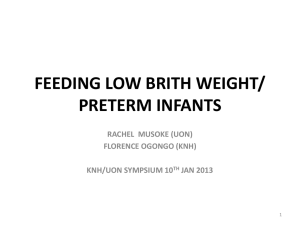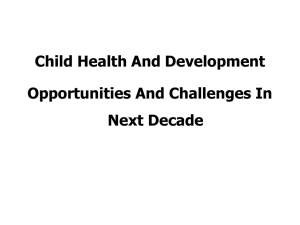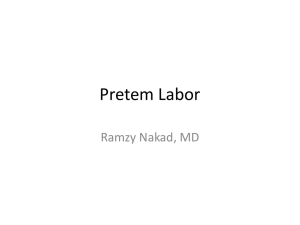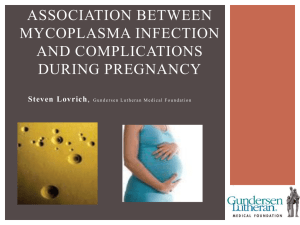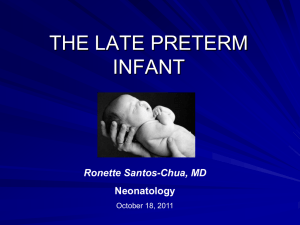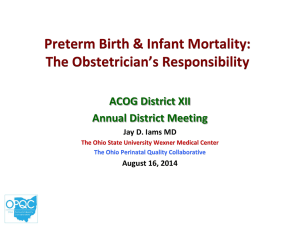Studying Health Within the NLSY
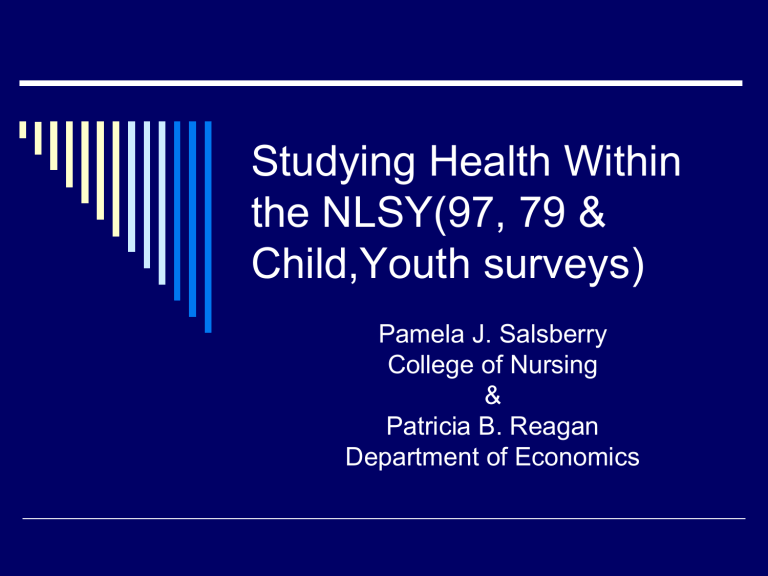
Studying Health Within the NLSY(97, 79 &
Child,Youth surveys)
Pamela J. Salsberry
College of Nursing
&
Patricia B. Reagan
Department of Economics
Outline
General comments about using the
NLSY79 and related child files for health related research
Specific data elements available for analysis —adult, child, youth surveys
Examples
Questions/comments
Why use the NLSY to study health —the positive argument
Interested in a life course perspective
Interested in sibling models to control for unobserved heterogeneity
Interested in the influence of family context on child health
Why use the NLSY to study health, continued
Interested in maternal influences on the health of her children
Examine health of the child’s impact on career trajectories of mothers
Examine the intersection of multiple influences on health outcomes across time
The negative argument or why the
NLSY is not good to examine health
Many data sets are available that may be more appropriate to your research questions (NHIS, NHANES, MEPS,
Medicare’s Current Beneficiary Survey)
Limited data on health status early on in
NLSY79 —related to ability to work
The negative argument, continued
Health data is self-reported
No physiological measures to confirm diagnosis, no laboratory data (e.g., BPs,
Cardiovascular indicators, EKGs)
Population based sample which can only be used to study relatively common health conditions
Adult Health Before Age 40
Height
Weight
Does health limit amount or kind of work respondent can do?
1979, 1980 specific conditions causing limitation
Health Module for those 40 years of age
CESD —7 items (92, 20-items; 94-7 items)
Parents health status (living/dead, age of death, cause of death)
SF-12
Health conditions- CVD, diabetes, asthma
Risky Behaviors and Health —
Adults (selected years)
Smoking (could be important to track for any asthma study)
Drug use
Seat belt use, attitudes towards risk
No diet or exercise histories
Health Insurance--Adults
Limited to 89, 90, 92-2004
Determines coverage status and who pays for the plan (e.g., private, Medicaid)
Same set of questions about the children and spouse
Health Services Utilization-
Adults Health at 40 Module
Health services use (last saw a health provider)
Important for ambulatory use sensitive conditions, like asthma
Health – Children of the NLSY
Does health limit ability to attend school or play (for preschool children)?
List of health disabling conditions (most frequent are asthma and learning disability)
Injuries and accidents
Height
Weight
Age of Menarche (females)
Health – Children of the NLSY
Continued
Birth weight
Length of gestation
Length
Maternal behaviors
Prepregnancy weight
Smoking during pregnancy
First trimester health care visit
Risky Behaviors
Asked only of those 10-14
Drug, alcohol, sexual activity
Health Insurance for the Child
Is child covered by health insurance provided by an employer or an individual plan?
Is child covered by Medicaid?
Health services use
Last time had routine health check
Last dental visit
Caution —question about required health care —wording leaves open the possibility of needing, but not receiving
Seen by psychiatrist, counselor, psychologist
Health Module for Young
Adults
Health limitations —work and school
List of health conditions
Health status question (Poor to
Excellent)
Accidents or injuries
Fertility modules
Height
Weight
Risky behaviors and Health —
Young Adults
Self report booklet —
Sex & birth control
Drugs & alcohol
Abortions
Health Insurance for the
Young Adults
Source of coverage —parent, employer, self
Covered by Medicaid?
Health services use —Young
Adult
Last time had routine health check
Last time seen for treatment of an illness
Caution —question about required health care —wording leaves open the possibility of needing, but not receiving
NLSY 97 Health
General Health
Height
Weight
Perceptions about weight
Chronic conditions Rounds 1 & 6
Age of menarche (females)
NLSY97 Risky Behaviors
Age>=14
Cigarettes, alcohol, drugs
Sexual behavior
Birth control
NLSY97- Health Insurance and Utilization of Services
Insurance coverage- Rounds 1 & 6
Visit doctor in past 12 months- Round 6
Research Applications
Birth Outcomes
Development of childhood overweight
Birth Outcomes- Mothers are
NLSY79 Respondents
Issues to consider:
Children born to teens occurred in the earliest years of the survey —by mid-
1980s all respondents were aged 20 --so that if you wish to ask questions about teen births then one must consider whether the time differences are important
Studying Birth Outcomes
Time trends in health care – for example
“scheduled” preterm deliveries have increased over the last 20 years
Birth weights
Gestational age —preterm deliveries
SGA and LGA determination
Variables of interest
Individual:
Age of mother, parity
Interval between pregnancies
Previous preterm infant
Maternal prepregnancy weight
Risk behaviors of the mother (smoking, drinking, drug use)
Individual SES —family income, marital status, education
Determining Prepregnancy
BMI
Recording of data slightly different
Height asked at three time points(1981,
1982, 1983(for women only) and 1985)
1981=400=4 feet, 0 inches
1983=feet and inches
1985=inches
There are some out of range values
Only self-report measures
Preterm Study: Reagan/Salsberry
Social Science and Medicine 2005
Research Aim: To examine effect of social context on differences among blacks, whites, and Hispanics in rates of moderately preterm
(gestation 33-36 weeks) and very preterm infants (<33 weeks) relative to term births.
Contextual Measure
Lifetime exposure to income inequality : fraction of mother’s life since age
14 that she had spent in a state with a Gini coefficient above the yearly median
Findings
Blacks > very preterm
First births < preterm/very preterm
Short interval pregnancies > preterm/very preterm
Drug use during pregnancy> preterm/very preterm
Cumulative exposure to income inequality Hispanics > very preterm
Studying Child Overweight
Questions slightly different
Need to convert to percentile rankings for age and sex
Use of CDC program to standardize BMI
Height in inches
Weight in ounces
Sex
Age in months
Studying Child Overweight
Measured vs. reported data
Question asked if child can be measured —if not, then measures are reported by the mother. There is a follow up question on how the data were obtained (except for 86 —question not asked). Generally 70% or more are measured. We have found that measured heights and weights result in less overweight than the self-report data,
Development of overweight in
Children: Salsberry/Reagan
Pediatrics 2005
Research aim: To examine the timing and extent of early life influences on the development of overweight in children from birth through age 7.
Sample
Children of the NLSY
NLSY79
Merged mom information, prenatal information, with child information
In this study we needed data at four time points —needed birth information, and interviews at 2/3, 4/5, 6/7
Findings
Prepregnancy obesity & Smoking during pregnancy > overweight 2/4
Prepregnancy obesity & Smoking during pregnancy > overweight 4/6 and 6/8 conditional on prior overweight
Race/ethnic differences
Comments/Discussion

